Empoli is hosting a new public art itinerary that weaves urban regeneration, collective participation and reflection on the city landscape. From Nov. 9, 2025 to Feb. 15, 2026, the Boule de Neige project, promoted by the Municipality of Empoli and curated by Sergio Risaliti and Antonella Nicola, will bring works by six contemporary artists to the streets and squares of the historic center, stimulating new perceptions of the area and enhancing hitherto neglected spaces. The artists involved, Marco Bagnoli, Francesca Banchelli, Chiara Bettazzi, MarcelaCastañeda Florian, Giovane Ceruti and David Reimondo, designed the works following site surveys and direct interactions with the city context, resulting in interventions that are deeply linked to local identity and conceived as moments of discovery and reflection for citizens and visitors.
The title of the project, Boule de Neige, recalls the object invented by Erwin Perzy in late 19th century Austria, capable of creating a microcosm suspended between reality and imagination: as in the glass sphere, art here is proposed as a contemplative experience that induces pause and reflection. The initiative stems from a grant from the Region of Tuscany, as part of a call dedicated to urban security that required municipalities to submit cultural and social proposals aimed at improving the quality of public spaces. The Municipality of Empoli won tenth place with a project that combines street educators and contemporary art, focusing on the capacity of creativity to generate social and urban transformations. The urban itinerary is developed through a careful mapping of disused museum, private and commercial spaces, transforming the center of Empoli into a laboratory of cultural and urban regeneration.

“The two areas featured in the project, Via Spartaco Lavagnini and Piazzetta Madonna della Quiete, rightfully enter a new urban cultural itinerary with a contemporary, bold language that mixes different stimuli to amaze visitors, residents and the curious,” said Alessio Mantellassi, mayor of Empoli. “These are two areas that since the start of our administration we are bringing back to the forefront with events, making vital areas that were considered marginal. One of the strategies is art that lends itself to shaping the urban landscape to give new light to these areas.”
“We have a diverse group of artists with different styles to create surprise and amazement, crossing different types of works (from projections to art installations),” said Matteo Bensi, councillor for Culture. “The urban face of Empoli lends itself well to contaminations and we are happy to act both on already known and appreciated places such as the cloister of the Museo della Collegiata to move on to less traveled streets in the center such as Via Lavagnini. This is the first time a project has developed so deeply in the city and we are happy to be able to experiment with the help of voices from Italy and the World.”
" Boule de Neige ’s is an innovative intervention," added Valentina Torrini, Councillor for Security, “which bets on the ability of art to heal and regenerate spaces, but also on the desire to make our historic center a common good, in which the interests of the owners of the vacant funds, the inhabitants and the administration meet, to give new light to the historic center thanks to the hand and ingenuity of young artists. Sincere thanks to the people who provided the unused funds, to the Tuscany Region that funded the Hugo Luci Accese Sulla città project, to the street educators, to the city employees, and to all those who have worked with us these months holding together care, regeneration, and urban safety. This is with the goal of transforming places where people often rush to get to the historic center, into spaces where they slow down to look around.”
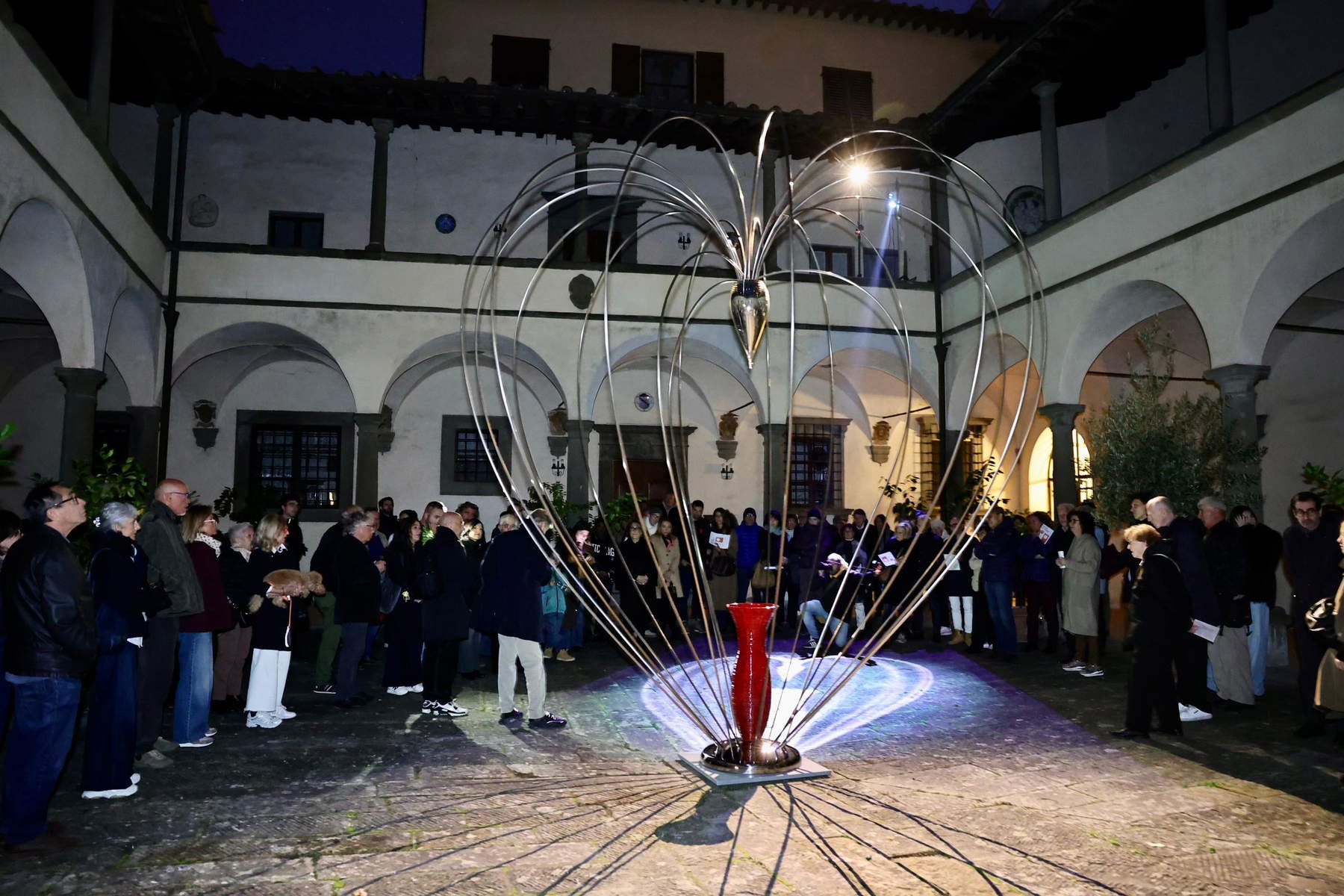
In the Cloisters of the Museum of the Collegiate Church of St. Andrew, Marco Bagnoli presents L’albero rovesciato (Della Luce innata), one of his iconic hot air balloons. The structure refers to the idea of flight as a process of transmutation, in which matter is lightened and becomes a space for inner reflection. The work invites the viewer to consider verticality as a symbolic element of contact between earthly and spiritual dimensions, transforming the viewer’s perception of space and breath. Bagnoli’s hot air balloons are thresholds between real and imaginary, transition points that amplify the relationship between matter and spirit, consolidating the dialogue with history and with the places that host the installation.
David Reimondo intervenes in the Piazzetta Madonna della Quiete with Nuovi Linguaggi Determinano la Nascita di Nuovi Mondi(New Languages Determine the Birth of New Worlds), a light installation that combines graphemes from his unpublished alphabet with verses from Dante ’s Divine Comedy dedicated to Farinata degli Uberti. The work invites slow and careful observation, stimulating the audience to question language, its structure and the relationship between historical memory and contemporary interpretive possibilities. The square becomes a space for meditation and deciphering cultural codes, offering an experience that links collective memory and openness to the new.
Via Spartaco Lavagnini hosts interventions by Francesca Banchelli, Chiara Bettazzi, Marcela Castañeda Florian and Giovane Ceruti. The windows of inactive stores are darkened and allow glimpses of the works only through small holes, transforming the act of observation into an intimate and suspended experience. The path is enriched by a carpet of lights and suspended objects, recalling the phantasmagoria of festivals and inviting reflection on the relationship between the individual, the collective and urban space.
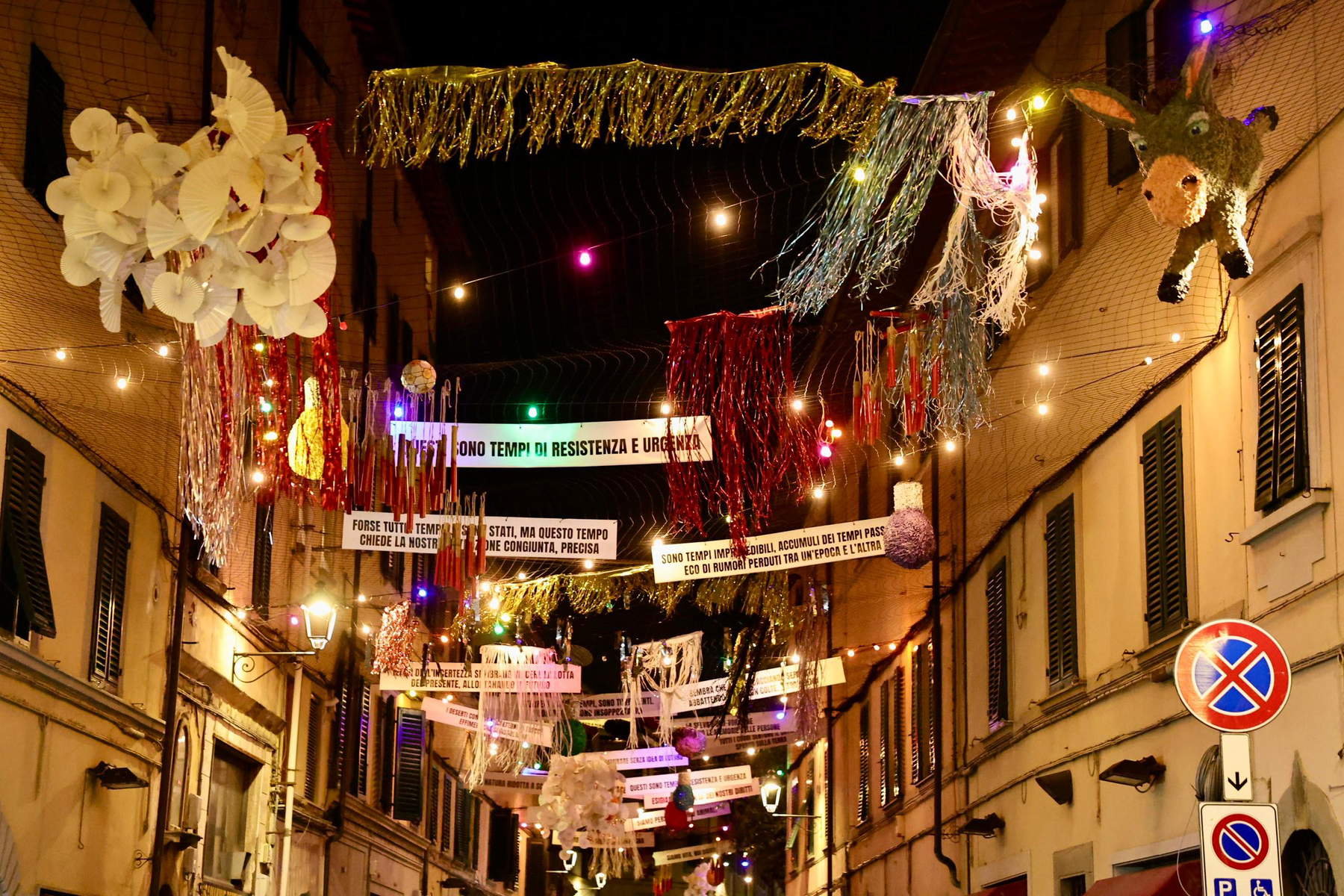
At no. 26, Francesca Banchelli proposes Dust to Dust, an installation that explores the relationship between darkness and light, with a clay and wax figure illuminated to the core, projecting a beam of light through the window. The sculpture, combined with mirrors and about 500 crystal drops, generates multiplied reflections in the public space, establishing a dialogue between the individual self and the collective.
At number 29, Chiara Bettazzi offers an installation inspired by Flemish still life painting and wunderkammer, the first collections of mirabilia and rarities. Outside, white fans swing in the wind, evoking symbols of elegance, mystery, reflection on identity and good luck wishes. The arrangement of the objects and fans creates a dialogue between indoor and outdoor space, transforming the street into a poetic path where observation becomes an active and meditative experience.
Marcela Castañeda Florian intervenes at number 36 with an installation that connects the individual and social dimensions, reflecting on the relationship between interiority and exterior reality. Through holes in the windows and texts from the artist’s manifesto We Are, the work invites us to consider the human being as an active protagonist of our own lives and of the community, with a focus on the link between space and community, accompanied by natural sounds generated by small suspended bamboo rattles.

At number 55, Giovane Ceruti proposes an installation that relates the everyday to the universe, connecting the individual to cosmic dimensions. The storefront serves as a symbolic geolocator, while colored polyurethane sculptures outside represent mythological and popular figures, creating a dialogue between memory, fantasy and urban space. The work suggests a reflection on singularity and collective connectedness, inviting recognition of one’s belonging to the universe and community.
“It is a beautiful collaboration between contemporary art and public administration,” said Sergio Risaliti, director of the Novecento Museum in Florence and curator of the Boule de Neige project, “a project of urban regeneration that starts from the analysis of a local context in which the need was felt to restore creative energy and the possibility of creating dialogue and sharing in a sector of the city that has experienced, over the years, a major change. The artists’ work rekindles curiosity and desire about storefronts that have been closed for a long time, a sign of the interruption of a commercial cycle, and they do so not through the typical canons of consumerist voyeurism, but through those of poetic and artistic awe and wonder. The darkened shop windows erase the previous time to open, through oculi, to boxes that let the gaze penetrate to small wunderkammer, chambers of wonder, boule de neige. It is precisely amazement and wonder that once again take center stage, restoring to the visitor the possibility of discovering another time: a slowing down, a breathing of the gaze that also awakens the poetic dimension of childhood, when the things of the world still did not serve in utilitarian terms, rather to create enchanted and imaginative worlds that aroused emotions and activated the free imagination. Two works were also installed in two special places in terms of history and function. The facade of the Church of Our Lady of Quietness. The second work will be found placed in the center of the cloister of the Collegiate Church of St. Andrew. Here the confrontation is enriched by a dialogue with the spirituality, culture, and traditions of Empoli. Thanks are due to the administration, the councilor, artists, companies and all those who contributed and made the project possible. I also want to thank Dean Pastor Don Guido Engels for his willingness to host Marco Bagnoli’s hot air balloon in the Cloister of the Museum of the Collegiate Church of St. Andrew. In urban regeneration operations such as these, where artistic interventions are activated, one should not speak of courage but of sensitivity. Rather of care and elevation than regeneration, which is the consequence. This means having understood the value of art in its political and spiritual dimensions. A therapy for the healing of the collective body based on the awakening of latent or annihilated energies, stimulated through the experience of wonder and curiosity. Art as a tool for elevation and liberation and only then for dialogue and reconciliation of tolerance and inclusion.”
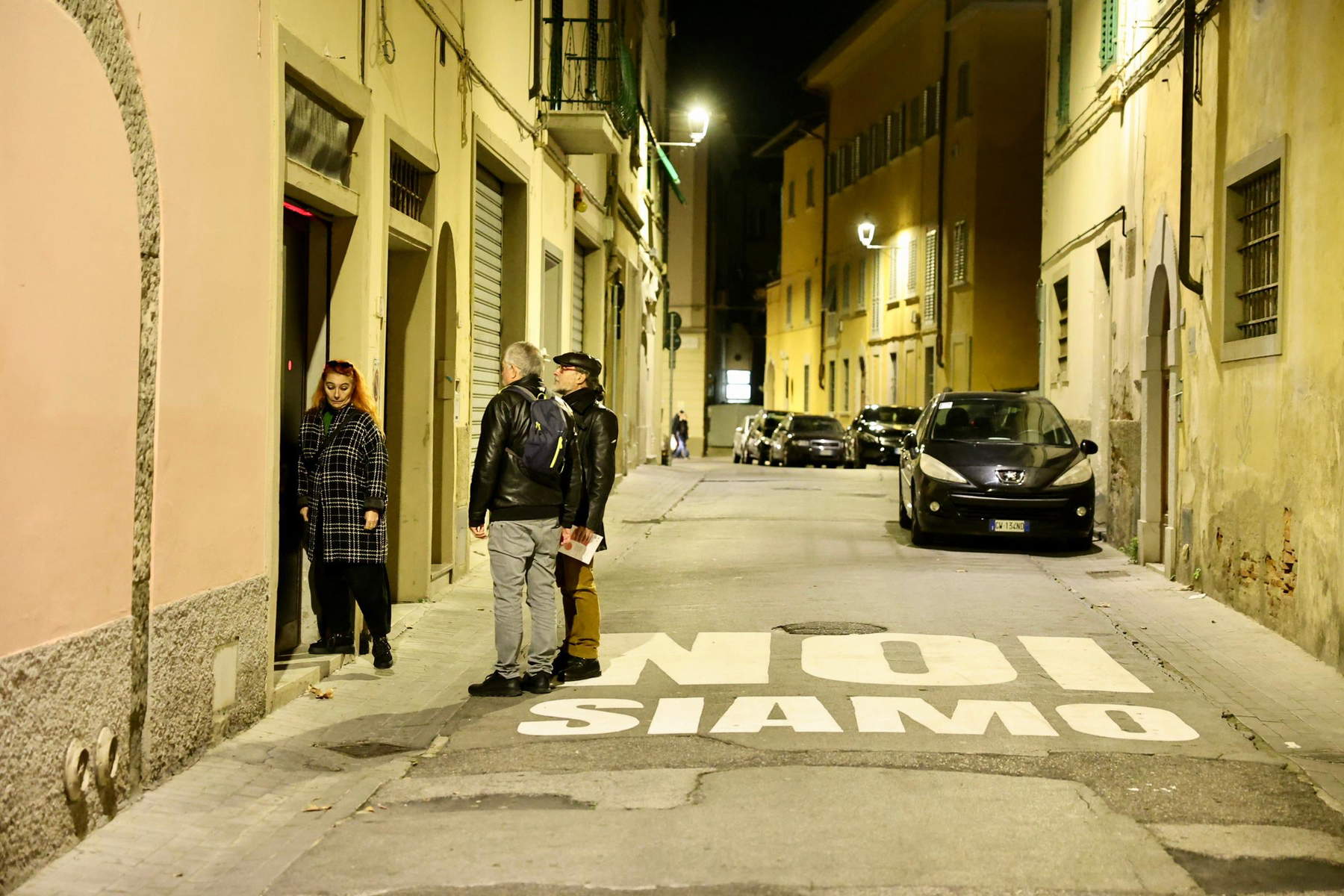
“The objects hung on the net,” said Antonella Nicola, co-curator of the project, “are not proposed as mere decorations, because they highlight the multiple nature of things: from Giovane Ceruti’s colorful and playful characters, which speak of collective imagination, to Marcela Castaneda’s socially and politically engaged posters to the caducity and beauty, at the same time, of life emphasized by Chiara Bettazzi’s fans, which are for one part plastic and for the other part paper: in fact, considering precisely the ephemeral nature of things, the artist wanted to include one of the objects in her still lifes, the fan, that could be subjected to change over time, like flowers that grow and wither. The wind, too, will be an accomplice in this project, stirring up Francesca Banchelli’s light and volatile luminous constellation and Marcela Castaneda’s bamboo canes, whose sound punctuates the walk down Via Lavagnini. We are urged to pay attention to the aspects of life, to the important and serious issues, but also to the small things, the details and the ephemeral, which often escape attention and instead conceal important meanings. In the end, this is somewhat the sense of the whole project, which extends to Marco Bagnoli’s important installation, which speaks of elevation and awakening, and David Raimondo’s installation, in which new thought processes are made possible: To stop and look at things from a different perspective and in a different time to allow different dynamics to sprout and to be filled with the wonder and beauty hidden in everything, making the experience of art one’s own.”
Boule de Neige thus constitutes a complex and articulated cultural itinerary that brings memory, collective identity and contemporaneity into dialogue. The project proposes a replicable model of urban regeneration that combines place enhancement, aesthetic experience and social participation, transforming the historic center of Empoli into an open laboratory of art and community, where the public becomes an active part of the creative process. The route invites people to observe the city carefully, to dwell on details, to perceive light, color and sign, offering a reflective experience that combines urban and poetic dimensions.
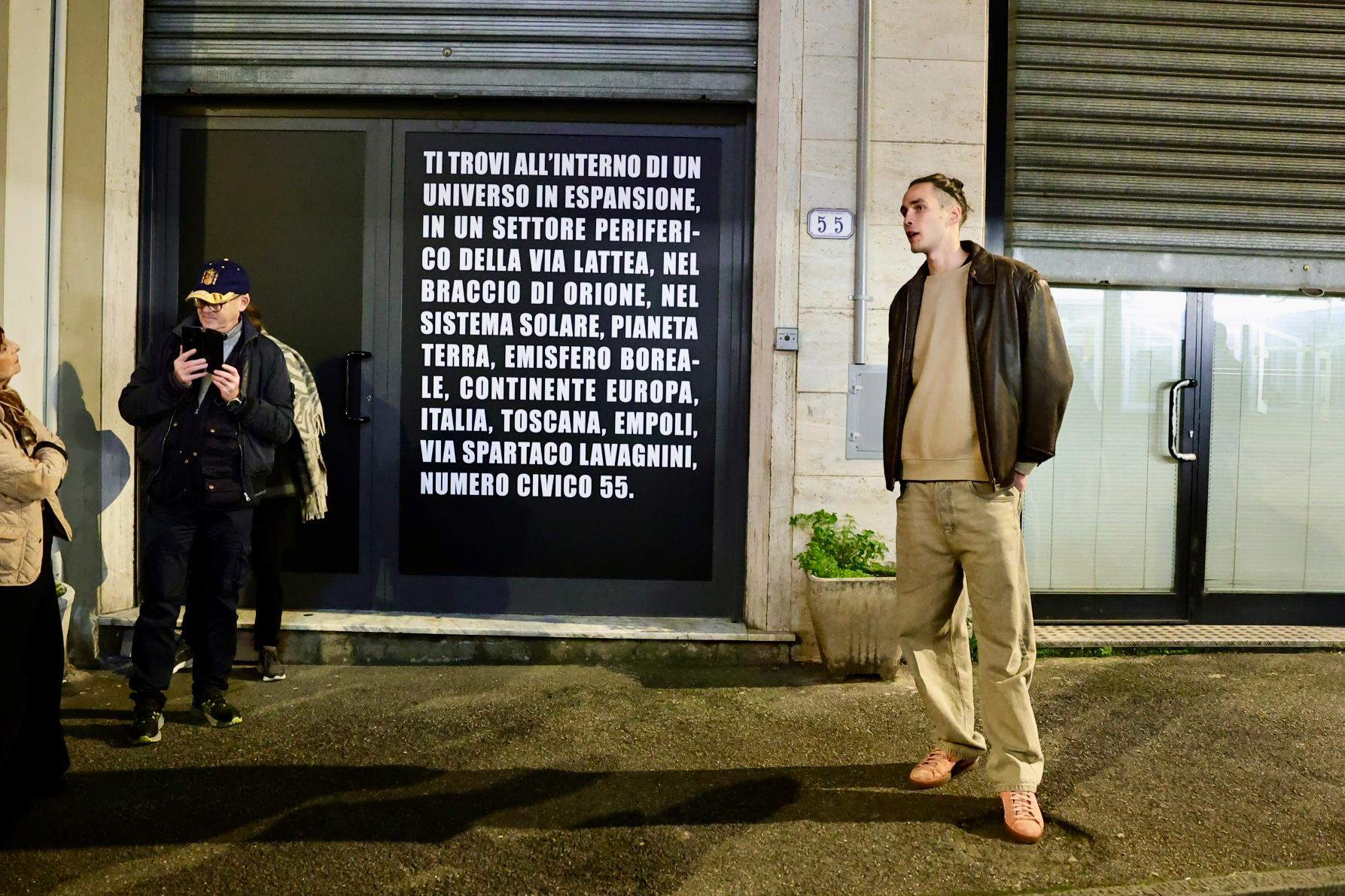
Marco Bagnoli (Empoli, 1949)
Active since the 1970s, Bagnoli develops his practice between painting, sculpture, drawing and environmental and sound installations. His works explore space, light and body perception, combining aesthetics, science and ancient knowledge in a contemporary language. He has exhibited in major Italian and international institutions, including the Venice Biennale, documenta in Kassel, Castello di Rivoli, Centre Georges Pompidou in Paris, and the National Art Museum of China.
David Reimondo (Genoa, 1973)
Reimondo’s work focuses on language, the individual and subjectivity as a contribution to the collective. Among his main tools areEtymography and Chromophonetics, systems he invented to reinvent the meaning of words and colors. He has exhibited in Italy and abroad, including Museo Novecento Florence, Mazzoleni Turin, The Open Box Milan, and numerous international events.
Francesca Banchelli (Montevarchi, 1981)
A multifaceted artist, she investigates time, the relationship between the conscious and the unconscious and the dialogue between man and nature. She works with performance, painting, sculpture, video and large-scale installations. She has exhibited in international institutions and galleries, including Centro Pecci Prato, Triennale Milano, Tate Modern London and Villa Romana Florence. She lives and works in Florence.
Chiara Bettazzi (Prato, 1977)
Her research explores urban space, everyday objects and memory through installations and photographs. The works weave accumulation and discard, reflecting on transformation and identity. She collaborates with artists and historians on site-specific projects, and is featured in public and private collections, including the Galleria Nazionale d’Arte Moderna e Contemporanea in Rome and Collezione Farnesina. She lives and works in Prato.
Marcela Castañeda Florian (Bogota, 1992).
Through installations and site-specific interventions, she explores the human being as an individual and part of the collective. Her works reflect on memory, identity and social responsibility. He lives and works in Florence, with educational experiences in plastic arts and decoration at the Academy of Fine Arts in Florence.
Giovane Ceruti (Florence, 2000)
An emerging visual artist, he trained in Florence at the Florence Academy of Fine Arts in the degree course in Painting - New Expressive Languages, graduating in 2025. His research crosses different means of expression, with a focus on language, irony as a filter to observe and show the contradictions of the present, and the space of the everyday as a ground for reflection. Ceruti has already participated in various contemporary art fairs, including Arte Fiera 48 in Bologna, Cremona Art Fair and Flashback Habitat in Turin.
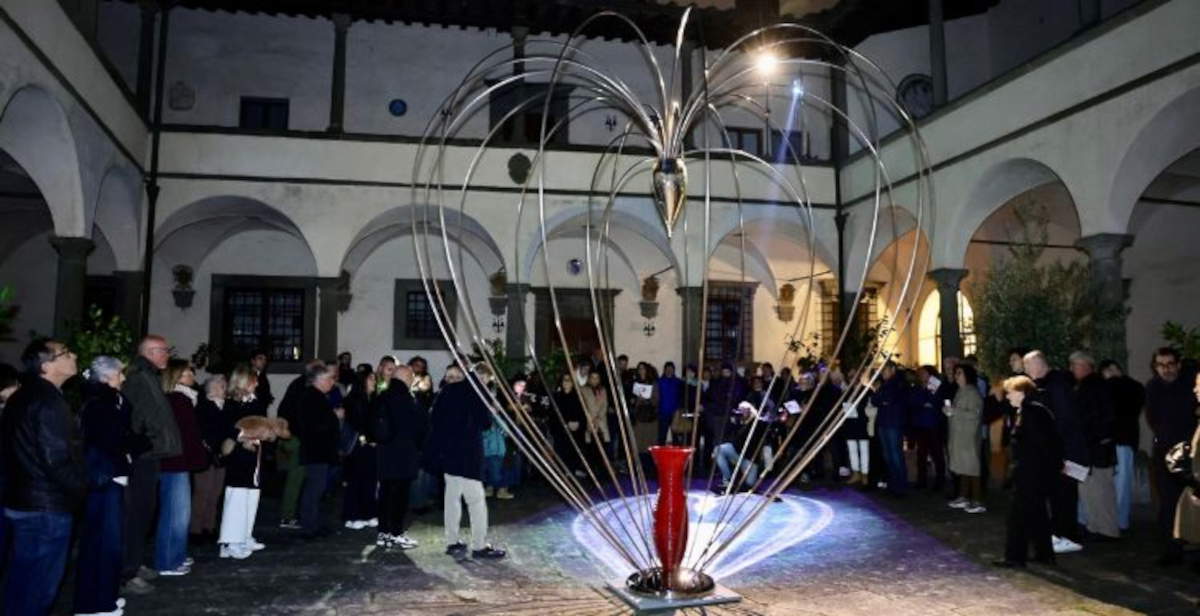 |
| Empoli hosts a public art project with six major artists: here's Boule de Neige |
Warning: the translation into English of the original Italian article was created using automatic tools. We undertake to review all articles, but we do not guarantee the total absence of inaccuracies in the translation due to the program. You can find the original by clicking on the ITA button. If you find any mistake,please contact us.